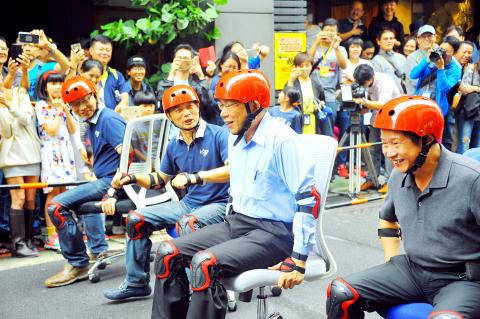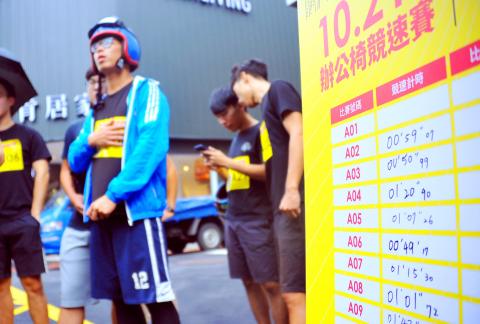Chen Ying-hua (陳映華) was not upset about having to sit in an office chair on a Saturday afternoon after doing so all week. He was pretty excited, in fact, and ended the day with NT$15,000 to spend on furniture.
“I did not expect this to happen at all,” he says.
With no prior experience, Chen and teammate Chien Wen-sheng (簡汶昇) beat out about 70 teams to capture top honors at the first ever office chair race in Taipei. Organized by the Wenchang Furniture Street Development Association, participants whiz, trudge or stumble their way down a 70-meter course riding an office chair in a two-way relay. The rules are simple: participants must remain firmly seated and are only allowed to use their legs to propel forward. Chen and Chien clocked in at 38 seconds.

Photo: Han Cheung, Taipei Times
Office chair racing traces its origins to the struggling Kyotanabe shopping district in Kyoto. In March 2010, the area’s cooperative association put on the race to attract shoppers and was met with unexpected enthusiasm. The event has since spread throughout Japan, with the first Taiwan race being held last year in Tainan.
Wenchang Furniture Street Development Association director Liu Song-hsiung (劉松雄) says that they have organized a promotional street fair for the past nine years, but this year decided to shake things up.
“Business has been a bit slow these days,” he says. “We saw the races in Japan, and since office chairs are part of the furniture industry, we thought it would be a great fit.”

Event staff Su Yi-kai (蘇羿凱) says that while Japan’s races usually involve turning on multiple streets, for their inaugural race they kept things simple with a straight course.
Liu, Taipei Mayor Ko Wen-je (柯文哲) and other association officials kicked off the competition with a short demonstration, and the race was on.
Chen, who participates in running events, says that he saw the office chair races on Facebook and signed up because he “wanted to try something new.”
“We roll around in office chairs at work when we’re too lazy to get up to get something anyway,” he says. “But we did test out the chairs a bit before the race to find the best position.”
Su says that the fastest way to the finish line is to sit on one’s side while facing forward. Chen and Chien, for their part, took the crown by pushing with their backs toward the finish line. All types of positions were observed on Saturday. People fell and crashed, and shoes were lost.
Chen Yi-fu (陳奕甫) says it was much more exhausting than he had imagined, citing the unfamiliarity toward the propelling motions as well as the sloped and coarse ground.
“My calves were stiff,” he says. “Halfway to the finish line, I thought, ‘Why am I not there yet?’ One can usually run 70m in about nine seconds.”
He says he joined because “if you do this on your own, people will think you’re an idiot.”
“Here, everyone can be idiots,” he adds.
Even though Chuo Yu-ting (卓毓庭) was among those who crashed and fell, she is eager to straighten the record at the next event.
“I don’t think I was seated too firmly,” she says. “When I crashed, my shoe came loose as well. So for the rest of the way, I had to watch my shoe and couldn’t fully concentrate. I’ll definitely be back now that I know how to do it.”

The canonical shot of an East Asian city is a night skyline studded with towering apartment and office buildings, bright with neon and plastic signage, a landscape of energy and modernity. Another classic image is the same city seen from above, in which identical apartment towers march across the city, spilling out over nearby geography, like stylized soldiers colonizing new territory in a board game. Densely populated dynamic conurbations of money, technological innovation and convenience, it is hard to see the cities of East Asia as what they truly are: necropolises. Why is this? The East Asian development model, with

June 16 to June 22 The following flyer appeared on the streets of Hsinchu on June 12, 1895: “Taipei has already fallen to the Japanese barbarians, who have brought great misery to our land and people. We heard that the Japanese occupiers will tax our gardens, our houses, our bodies, and even our chickens, dogs, cows and pigs. They wear their hair wild, carve their teeth, tattoo their foreheads, wear strange clothes and speak a strange language. How can we be ruled by such people?” Posted by civilian militia leader Wu Tang-hsing (吳湯興), it was a call to arms to retake

This is a deeply unsettling period in Taiwan. Uncertainties are everywhere while everyone waits for a small army of other shoes to drop on nearly every front. During challenging times, interesting political changes can happen, yet all three major political parties are beset with scandals, strife and self-inflicted wounds. As the ruling party, the Democratic Progressive Party (DPP) is held accountable for not only the challenges to the party, but also the nation. Taiwan is geopolitically and economically under threat. Domestically, the administration is under siege by the opposition-controlled legislature and growing discontent with what opponents characterize as arrogant, autocratic

Desperate dads meet in car parks to exchange packets; exhausted parents slip it into their kids’ drinks; families wait months for prescriptions buy it “off label.” But is it worth the risk? “The first time I gave him a gummy, I thought, ‘Oh my God, have I killed him?’ He just passed out in front of the TV. That never happens.” Jen remembers giving her son, David, six, melatonin to help him sleep. She got them from a friend, a pediatrician who gave them to her own child. “It was sort of hilarious. She had half a tub of gummies,